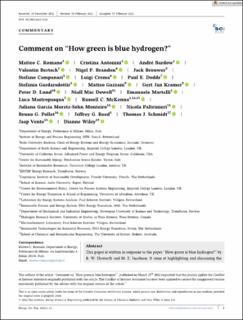| dc.contributor.author | Romano, Matteo C. | |
| dc.contributor.author | Antonini, Cristina | |
| dc.contributor.author | Bardow, André | |
| dc.contributor.author | Bertsch, Valentin | |
| dc.contributor.author | Brandon, N.P. | |
| dc.contributor.author | Brouwer, Jack | |
| dc.contributor.author | Campanari, Stefano | |
| dc.contributor.author | Crema, Luigi | |
| dc.contributor.author | Dodds, Paul E. | |
| dc.contributor.author | Gardarsdottir, Stefania Osk | |
| dc.contributor.author | Gazzani, Matteo | |
| dc.contributor.author | Kramer, Gert Jan | |
| dc.contributor.author | Lund, Peter D. | |
| dc.contributor.author | Mac Dowell, Niall | |
| dc.contributor.author | Martelli, Emanuele | |
| dc.contributor.author | Mastropasqua, Luca | |
| dc.contributor.author | McKenna, Russell | |
| dc.contributor.author | Monteiro, Juliana Garcia Moretz-Sohn | |
| dc.contributor.author | Paltrinieri, Nicola | |
| dc.contributor.author | Pollet, Bruno | |
| dc.contributor.author | Reed, Jeffrey G. | |
| dc.contributor.author | Schmidt, Thomas Justus | |
| dc.contributor.author | Vente, Jaap | |
| dc.contributor.author | Wiley, Dianne | |
| dc.date.accessioned | 2022-07-21T07:33:37Z | |
| dc.date.available | 2022-07-21T07:33:37Z | |
| dc.date.created | 2022-05-25T09:12:31Z | |
| dc.date.issued | 2022 | |
| dc.identifier.issn | 2050-0505 | |
| dc.identifier.uri | https://hdl.handle.net/11250/3007444 | |
| dc.description.abstract | This paper is written in response to the paper “How green is blue hydrogen?” by R. W. Howarth and M. Z. Jacobson. It aims at highlighting and discussing the method and assumptions of that paper, and thereby providing a more balanced perspective on blue hydrogen, which is in line with current best available practices and future plant specifications aiming at low CO2 emissions. More specifically, in this paper, we show that: (i) the simplified method that Howarth and Jacobson used to compute the energy balance of blue hydrogen plants leads to significant overestimation of CO2 emissions and natural gas (NG) consumption and (ii) the assumed methane leakage rate is at the high end of the estimated emissions from current NG production in the United States and cannot be considered representative of all-NG and blue hydrogen value chains globally. By starting from the detailed and rigorously calculated mass and energy balances of two blue hydrogen plants in the literature, we show the impact that methane leakage rate has on the equivalent CO2 emissions of blue hydrogen. On the basis of our analysis, we show that it is possible for blue hydrogen to have significantly lower equivalent CO2 emissions than the direct use of NG, provided that hydrogen production processes and CO2 capture technologies are implemented that ensure a high CO2 capture rate, preferably above 90%, and a low-emission NG supply chain. | en_US |
| dc.description.abstract | Comment on “How green is blue hydrogen?" | en_US |
| dc.language.iso | eng | en_US |
| dc.publisher | Wiley | en_US |
| dc.rights | Navngivelse 4.0 Internasjonal | * |
| dc.rights.uri | http://creativecommons.org/licenses/by/4.0/deed.no | * |
| dc.title | Comment on “How green is blue hydrogen?" | en_US |
| dc.title.alternative | Comment on “How green is blue hydrogen?" | en_US |
| dc.type | Peer reviewed | en_US |
| dc.type | Journal article | en_US |
| dc.description.version | publishedVersion | en_US |
| dc.rights.holder | The Authors | en_US |
| dc.source.journal | Energy Science & Engineering | en_US |
| dc.identifier.doi | 10.1002/ese3.1126 | |
| dc.identifier.cristin | 2027184 | |
| cristin.ispublished | true | |
| cristin.fulltext | original | |
| cristin.qualitycode | 1 | |

